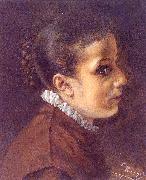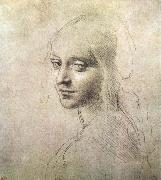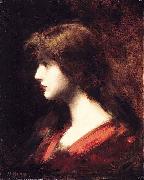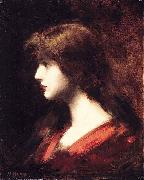
Oil On
Canvas, Real Flavor of Old Masters
|
Adolph von Menzel
|
|||
|
|
|||
| 1815-1905 German Adolph von Menzel Gallery His father was the headmaster of a school for girls, and intended to educate his son as a professor; but he would not thwart his taste for art. Left an orphan in 1832, Menzel had to maintain his family. In 1833 Sachse of Berlin published his first work, an album of pen-and-ink drawings reproduced on stone, to illustrate Goethe's little poem, Kunstlers Erdenwallen. He executed lithographs in the same manner to illustrate Denkw??rdigkeiten aus der brandenburgisch-preussischen Geschichte; The Five Senses and The Prayer, as well as diplomas for various corporations and societies. From 1839 to 1842 he produced 400 drawings, largely introducing to Germany the technique of wood engraving, to illustrate the Geschichte Friedrichs des Grossen (History of Frederick the Great) by Franz Kugler. He subsequently brought out Friedrichs der Grossen Armee in ihrer Uniformirung (The Uniforms of the Army under Frederick the Great), Soldaten Friedrichs der Grossen (The Soldiers of Frederick the Great); and finally, by order of the king Frederick William IV, he illustrated the works of Frederick the Great, Illustrationen zu den Werken Friedricks des Grossen (1843-1849). By these works Menzel established his claim to be considered one of the first, if not actually the first, of the illustrators of his day in his own line. Pencil drawing by Menzel, 1891.Meanwhile Menzel had set himself to study unaided the art of painting, and he soon produced a great number and variety of pictures, always showing keen observation and honest workmanship in subjects dealing with the life and achievements of Frederick the Great, and scenes of everyday life, such as In the Tuileries, The Ball Supper, and At Confession. Among the most important of these works are The Forge (1875) and The Market-place at Verona. Invited to paint The Coronation of William I at Koenigsberg, he produced an exact representation of the ceremony without regard to the traditions of official painting. In Germany he received many honors, and was the first painter to be given the Order of the Black Eagle in 1898 which included a title of nobility, becoming von Menzel. | |||
|
|
|||
|
|
Head of a Girl new5/Adolph von Menzel_SfVhjF.jpg Painting ID:: 19393 Visit European Gallery |
1851 Gouache Museum of Fine Arts, Leipzig. | |
Height Width |
INS/CM |
||
|
X |
|
||
|
|
|||
|
LEONARDO da Vinci
|
|||
|
|
|||
| Italian High Renaissance Painter and Inventor, 1452-1519 Italian High Renaissance Painter and Inventor, 1452-1519 Florentine Renaissance man, genius, artist in all media, architect, military engineer. Possibly the most brilliantly creative man in European history, he advertised himself, first of all, as a military engineer. In a famous letter dated about 1481 to Ludovico Sforza, of which a copy survives in the Codice Atlantico in Milan, Leonardo asks for employment in that capacity. He had plans for bridges, very light and strong, and plans for destroying those of the enemy. He knew how to cut off water to besieged fortifications, and how to construct bridges, mantlets, scaling ladders, and other instruments. He designed cannon, very convenient and easy of transport, designed to fire small stones, almost in the manner of hail??grape- or case-shot (see ammunition, artillery). He offered cannon of very beautiful and useful shapes, quite different from those in common use and, where it is not possible to employ cannon ?? catapults, mangonels and trabocchi and other engines of wonderful efficacy not in general use. And he said he made armoured cars, safe and unassailable, which will enter the serried ranks of the enemy with their artillery ?? and behind them the infantry will be able to follow quite unharmed, and without any opposition. He also offered to design ships which can resist the fire of all the heaviest cannon, and powder and smoke. The large number of surviving drawings and notes on military art show that Leonardo claims were not without foundation, although most date from after the Sforza letter. Most of the drawings, including giant crossbows (see bows), appear to be improvements on existing machines rather than new inventions. One exception is the drawing of a tank dating from 1485-8 now in the British Museum??a flattened cone, propelled from inside by crankshafts, firing guns. Another design in the British Museum, for a machine with scythes revolving in the horizontal plane, dismembering bodies as it goes, is gruesomely fanciful. Most of the other drawings are in the Codice Atlantico in Milan but some are in the Royal Libraries at Windsor and Turin, in Venice, or the Louvre and the École des Beaux Arts in Paris. Two ingenious machines for continuously firing arrows, machine-gun style, powered by a treadmill are shown in the Codice Atlantico. A number of other sketches of bridges, water pumps, and canals could be for military or civil purposes: dual use technology. Leonardo lived at a time when the first artillery fortifications were appearing and the Codice Atlantico contains sketches of ingenious fortifications combining bastions, round towers, and truncated cones. Models constructed from the drawings and photographed in Calvi works reveal forts which would have looked strikingly modern in the 19th century, and might even feature in science fiction films today. On 18 August 1502 Cesare Borgia appointed Leonardo as his Military Engineer General, although no known building by Leonardo exists. Leonardo was also fascinated by flight. Thirteen pages with drawings for man-powered aeroplanes survive and there is one design for a helicoidal helicopter. Leonardo later realized the inadequacy of the power a man could generate and turned his attention to aerofoils. Had his enormous abilities been concentrated on one thing, he might have invented the modern glider. | |||
|
|
|||
|
|
Head of a girl new21/LEONARDO da Vinci-963342.jpg Painting ID:: 63027 Visit European Gallery |
1483 Silverpoint and white highlights on prepared paper, 181 x 159 mm Biblioteca Reale, Turin The eminent art expert Bernhard Berenson called this sheet "the most beautiful drawing in the world." It is thought to be a study for the angel in the Virgin of the Rocks in the Musee du Louvre, Paris. Artist: LEONARDO da Vinci Painting Title: Head of a girl , 1451-1500 Painting Style: Italian , graphics Type: study | |
Height Width |
INS/CM |
||
|
X |
|
||
|
|
|||
|
unknow artist
|
|||
|
|
|||
|
|
|||
|
|
Head of a Girl new23/unknow artist-974479.jpg Painting ID:: 72211 Visit European Gallery |
19th century Oil on canvas 40.6 X 32.4 cm (15.98 X 12.76 in) cjr | |
Height Width |
INS/CM |
||
|
X |
|
||
|
|
|||
|
Jean-Jacques Henner
|
|||
|
|
|||
| 1829-1905 French Jean Jacques Henner Galleries French painter. He was born into a peasant family in the Sundgau and received his first artistic training at Altkirch with Charles Goutzwiller (1810-1900) and later in Strasbourg in the studio of Gabriel-Christophe Gu?rin (1790-1846). In 1846 he enrolled at the Ecole des Beaux-Arts in Paris as a pupil of Michel-Martin Drolling and, from 1851, of Francois-Edouard Picot. While a student he was particularly drawn to portraiture, and during his frequent visits to Alsace he made portraits of his family as well as of the notables of the region. He also painted scenes of Alsatian peasant life. | |||
|
|
|||
|
|
Head of a Girl new24/Jean-Jacques Henner-636593.jpg Painting ID:: 73839 Visit European Gallery |
Date 19th century Medium Oil on canvas Dimensions 40.6 X 32.4 cm (15.98 X 12.76 in) cyf | |
Height Width |
INS/CM |
||
|
X |
|
||
|
|
|||










